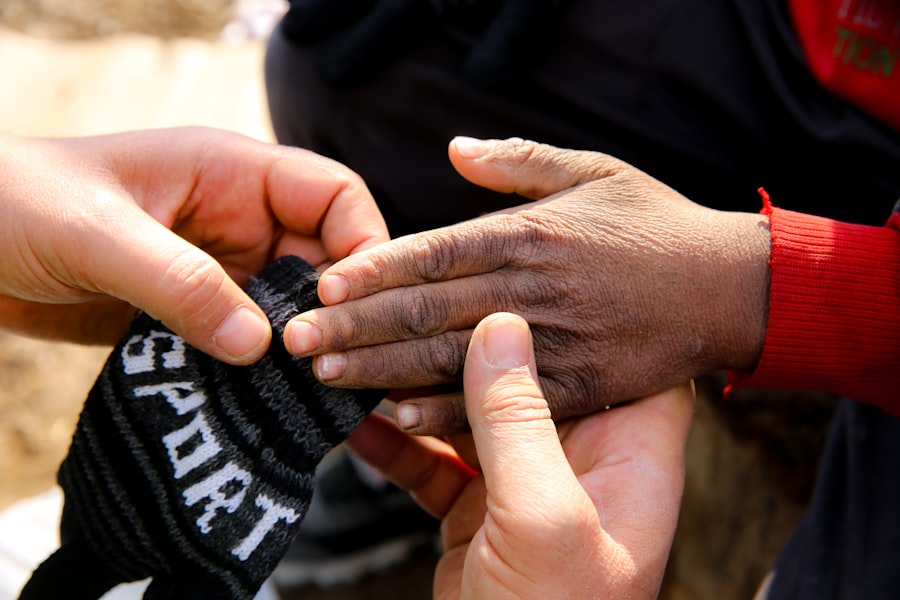
As the world grapples with the escalating effects of climate change, a new category of displaced individuals has emerged: climate refugees. These are people who are forced to leave their homes due to environmental changes that threaten their livelihoods and safety. Unlike traditional refugees, who flee from conflict or persecution, climate refugees are driven by the gradual degradation of their environment, which can include rising sea levels, extreme weather events, and prolonged droughts.
This phenomenon is becoming increasingly prevalent, as scientific evidence suggests that climate change is intensifying and affecting millions of lives across the globe. You may wonder how climate refugees differ from other displaced populations. The distinction lies primarily in the cause of their displacement.
While political instability or violence may lead others to seek refuge, climate refugees are often fleeing from natural disasters or the slow onset of environmental degradation. This unique situation complicates their status under international law, as there is currently no specific legal framework that recognizes climate refugees as a distinct group deserving of protection. As you delve deeper into this issue, it becomes clear that understanding the plight of climate refugees is crucial for developing effective responses to their needs.
Key Takeaways
- Climate refugees are individuals who are forced to leave their homes due to the impact of climate change, such as natural disasters, sea-level rise, and extreme weather events.
- The causes of climate refugees include environmental degradation, loss of livelihoods, food and water scarcity, and the destruction of homes and infrastructure.
- Climate refugees often face significant challenges, including loss of community and culture, increased vulnerability to exploitation and human trafficking, and limited access to basic services and resources.
- The international response to climate refugees is limited, and there is a lack of legal framework to protect and support these individuals.
- Climate change plays a significant role in forced migration, and addressing the root causes of climate change is crucial in mitigating the impact on vulnerable communities and finding long-term solutions for climate refugees.
Causes of Climate Refugees
The causes of climate-induced displacement are multifaceted and interconnected. One of the most significant factors is the increasing frequency and intensity of extreme weather events, such as hurricanes, floods, and wildfires. These disasters can devastate communities, destroy homes, and disrupt local economies, forcing individuals to seek safety elsewhere.
For instance, you might recall the catastrophic impact of Hurricane Katrina in 2005, which displaced thousands of residents in New Orleans and highlighted the vulnerability of coastal cities to climate-related disasters. In addition to extreme weather events, gradual environmental changes also contribute to the rise of climate refugees. Rising sea levels, driven by melting ice caps and thermal expansion of seawater, threaten low-lying coastal areas around the world.
As you consider places like Bangladesh or the Maldives, it becomes evident that entire communities face existential threats from encroaching waters. Furthermore, prolonged droughts and desertification can render agricultural land unproductive, leading to food insecurity and economic instability. In regions where livelihoods depend on agriculture, such as sub-Saharan Africa, these changes can push families to migrate in search of more viable living conditions.
Impact on Vulnerable Communities

The impact of climate-induced displacement is particularly pronounced among vulnerable communities. Often, these groups are already marginalized due to socio-economic factors such as poverty, lack of access to education, and limited political representation. When environmental changes force them to leave their homes, they face additional challenges that exacerbate their vulnerabilities.
You may find it alarming that women, children, and indigenous populations are disproportionately affected by climate change and displacement. For instance, women often bear the brunt of household responsibilities during crises, making it harder for them to adapt or recover. Moreover, the loss of community ties and cultural heritage can have profound psychological effects on displaced individuals.
As you reflect on this issue, consider how uprooting from familiar surroundings can lead to feelings of isolation and despair. The disruption of social networks can hinder access to resources and support systems that are vital for recovery. In many cases, climate refugees find themselves in overcrowded urban areas or makeshift camps where living conditions are dire.
The lack of adequate shelter, sanitation, and healthcare can further compound their struggles, leading to increased health risks and social tensions.
Challenges Faced by Climate Refugees
Climate refugees encounter a myriad of challenges as they navigate their new realities. One significant hurdle is the legal ambiguity surrounding their status. Unlike traditional refugees who are protected under international law, climate refugees often lack formal recognition and support from governments or international organizations.
This legal gap leaves them vulnerable to exploitation and discrimination in host countries. You might consider how this uncertainty affects their ability to access basic services such as education, healthcare, and employment opportunities. Additionally, climate refugees often face xenophobia and hostility in their new environments.
As they arrive in unfamiliar places seeking refuge, they may encounter resistance from local populations who perceive them as a burden on resources or a threat to cultural identity. This social friction can lead to further marginalization and isolation for climate refugees. You may find it disheartening that even in situations where host communities are sympathetic to their plight, limited resources can create competition for jobs and housing, exacerbating tensions between newcomers and residents.
International Response and Legal Framework
The international response to the plight of climate refugees has been slow and fragmented. While various organizations and governments acknowledge the growing crisis, there remains a lack of cohesive legal frameworks specifically addressing the rights and needs of climate-displaced individuals. The 1951 Refugee Convention does not encompass those fleeing environmental disasters, leaving many without adequate protection or assistance.
As you explore this issue further, you may recognize the urgent need for a comprehensive international legal framework that explicitly addresses climate-induced displacement. In recent years, some progress has been made through initiatives such as the Global Compact for Safe, Orderly and Regular Migration adopted by the United Nations in 2018. This agreement emphasizes the importance of addressing the needs of migrants affected by climate change and encourages countries to develop policies that protect them.
However, implementation remains inconsistent across nations. You might ponder how effective collaboration between governments, NGOs, and international organizations is essential for creating a robust support system for climate refugees.
Role of Climate Change in Forced Migration

Climate change plays a pivotal role in forced migration patterns worldwide. As environmental conditions deteriorate due to rising temperatures and extreme weather events, more individuals find themselves compelled to leave their homes in search of safety and stability. You may be surprised to learn that projections indicate that by 2050, up to 200 million people could be displaced due to climate-related factors alone.
This staggering figure underscores the urgency of addressing climate change not only as an environmental issue but also as a humanitarian crisis. The interplay between climate change and migration is complex; it often involves a combination of environmental degradation and socio-economic factors that drive individuals to migrate. For example, you might consider how a farmer facing prolonged drought may not only lose their crops but also their livelihood, prompting them to seek opportunities elsewhere.
In this context, climate change acts as a “threat multiplier,” exacerbating existing vulnerabilities and pushing people toward migration as a survival strategy.
Solutions and Mitigation Strategies
Addressing the challenges faced by climate refugees requires a multifaceted approach that encompasses both immediate relief efforts and long-term mitigation strategies. One crucial aspect is enhancing resilience in vulnerable communities through sustainable development initiatives. By investing in infrastructure improvements, disaster preparedness programs, and sustainable agricultural practices, you can help communities better withstand the impacts of climate change and reduce the need for migration.
Furthermore, international cooperation is essential for developing comprehensive policies that protect climate refugees’ rights while addressing the root causes of displacement. You might consider how countries can work together to share resources and knowledge in order to create effective adaptation strategies. This could involve establishing legal frameworks that recognize climate-induced displacement or providing financial support for affected communities to rebuild their lives sustainably.
Future Outlook for Climate Refugees
As you contemplate the future outlook for climate refugees, it becomes evident that proactive measures are essential to mitigate the impending crisis. The increasing frequency of extreme weather events and gradual environmental changes will likely continue to drive displacement in the coming decades. Without concerted global action on climate change mitigation and adaptation strategies, you may witness an escalation in the number of individuals seeking refuge from environmental disasters.
However, there is also hope for positive change through increased awareness and advocacy efforts surrounding the plight of climate refugees. As more people recognize the urgency of this issue, there is potential for greater political will to address it at both national and international levels. You might find it encouraging that grassroots movements advocating for climate justice are gaining momentum worldwide, pushing governments to take action on behalf of those most affected by climate change.
In conclusion, understanding the complexities surrounding climate refugees is crucial for fostering empathy and driving meaningful action. By recognizing their unique challenges and advocating for comprehensive solutions, you can contribute to a more just response to this pressing global issue. The future may be uncertain for many displaced by climate change, but with collective effort and commitment to sustainable practices, there is potential for a brighter outlook ahead.
Climate Refugees: The Hidden Human Impact of Global Warming sheds light on the devastating consequences of climate change on vulnerable populations around the world. This article highlights the urgent need for action to address the growing number of climate refugees who are forced to flee their homes due to rising sea levels, extreme weather events, and other environmental challenges. For more information on how planting trees can help mitigate the effects of climate change, check out Disadvantages of Planting Trees for Climate Change.
FAQs
What are climate refugees?
Climate refugees are people who are forced to leave their homes and communities due to the effects of climate change, such as rising sea levels, extreme weather events, and drought.
How many climate refugees are there?
It is difficult to determine an exact number of climate refugees, as the concept is still relatively new and there is no official definition or designation for climate refugees. However, it is estimated that there are millions of people around the world who have been displaced due to climate change.
What are the causes of climate refugees?
Climate refugees are primarily caused by the impacts of global warming, including rising sea levels, extreme weather events such as hurricanes and typhoons, and prolonged droughts. These environmental changes can make certain areas uninhabitable, forcing people to leave their homes.
Where do climate refugees come from?
Climate refugees come from all over the world, but some of the most affected regions include low-lying island nations, coastal areas, and regions prone to extreme weather events and droughts.
What are the challenges faced by climate refugees?
Climate refugees face a range of challenges, including loss of homes and livelihoods, food and water shortages, and the risk of conflict and instability in the areas to which they are displaced. They also often lack legal protections and recognition as refugees, which can make it difficult for them to access assistance and support.





